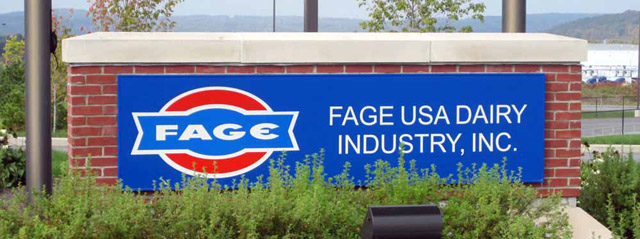Click the image above to see the Fage USA gallery.
Several types of systems are an integral part of this facility:
- Two (2) Quell type sprinkler systems
- Two (2) pre-action type sprinkler systems installed in the cooling tunnels
- Two (2) dry pipe sprinkler system
- Two (2) ESFR (Early Suppression Fast Response) sprinkler systems.
- Four (4) wet pipe sprinkler systems
Stainless Steel piping is normally installed in a “clean room” type of environment In this particular instance, stainless steel piping was installed throughout the processing areas of the building, as a part of both the pre-action and dry pipe sprinkler systems per USDA recommendations.
A 3,000 GPM @ 85 PSI fire pump was installed to transport the water flow to the dry pipe sprinkler system where high pile cold storage may be stacked up to and over 40 feet high.
The patent-pending Quell Fire Sprinkler System is the first of its kind for cold storage, outdoor and unheated warehouse facilities. In terms of performance, the Quell Fire Sprinkler System effectively addresses a fire with a volume of water with a “surround and drown” configuration to rapidly reduce the heat release rate. This fire protection approach minimizes damage to storage facilities and valuable goods. This allows the absence of in-rack sprinklers which is key to building owners. The Quell system does not require expensive antifreeze. Ceiling only coverage eliminates in rack sprinklers and increases storage array flexibility.
The ESFR (Early Suppression Fast Response) system incorporates large orifice sprinkler heads on larger pipe sizings. This type of system is also used, at times, in lieu of in rack sprinklers in storage type facilities. These heads are primarily intended to protect storage areas which tend to produce severe-challenge fires: palletized and solid pile storage and single, double or multiple row, and portable open rack storage. The sprinkler produces large, high-momentum water droplets in a hemispheric pattern below the deflector. This permits penetration of the fire plume and direct wetting of the burning fuel surface while cooling the atmosphere early in the development of a high-challenge fire.
